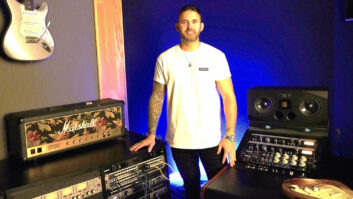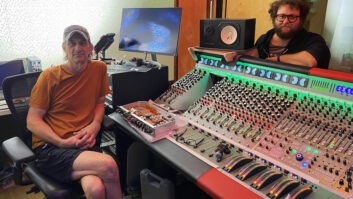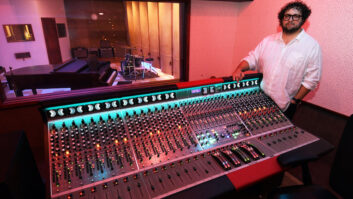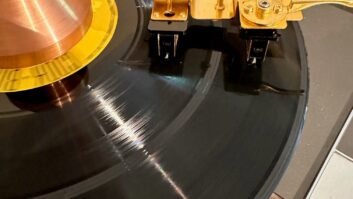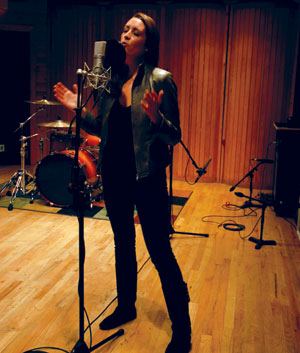
Anybody who has been in this business long enough can relate: You’ve recorded the perfect track, everything sounds amazing! The bass is phat, the drums have the best sound you’ve ever achieved. The guitars are sounding fresh, and you even worked out a clever hook. Now it’s time to record the vocal, and everything starts falling apart.
Vocals need to be thought out from the get-go, from the demo stage. This will allow you and the producer to first assess any musical problems: Is the song the right tempo for the lyrics? Is it the right key for the singer while at the same time maintaining the excitement? Is there enough space in the track melodically for the lead vocal? Do the lyrics convey the right message/emotion for the singer/band? If you have done your job right, these questions have all been addressed. Just remember, the most important thing to capturing a great vocal is to be prepared. Nothing kills a vocal session faster then technical problems, or having the artist wait while you set the I/O in your Pro Tools session.
The Environment
Always think about vibe first, then sound. The vocal should be done in a relaxed environment, wherever the singer feels most comfortable. Most of the time a singer will want a clean, warm and humid environment. Put up candles, lighting or lamps if it adds comfort. A performer needs to feel good. Sometimes the performance is better sitting, sometimes standing is better; sometimes lying down works, sometimes while dangling from a wire attached to the studio ceiling. There is no use renting out a big studio if the singer does not feel comfortable in the space. The vocals should be done wherever the singer feels the vibe—then worry about the technical side of things.
The Vocal Chain
I find it important to have a go-to vocal chain that you build on over the years. You know what it’s supposed to sound like, you know the gain staging as if it were second nature, and you will be able to tell right away if something is up from the singer’s perspective. You also will know right away if it is the right fit for the artist, so you can get to Plan B much quicker.

Your vocal microphone should be natural-sounding but not flat, and it should be versatile. It should be sonically flexible, meaning that it is okay being EQ’d. Some mics sound dull with no EQ but really come to life with a little touch. A good mic should also have a wide dynamic range and low signal-to-noise ratio. A lot of singers like to move in front of the mic during a long session (they don’t stay put in one place because you told them to!), so audition a wide-pattern mic.
Choose a quality preamp with lots of headroom and flexible gain control—I prefer continuous pots over step gain, and I prefer one that is clean but with a little character. Input/output transformers are great for adding a little character. Some people like to record flat—no EQ or compression—but I like to have my tools handy. I will typically go into a GML8200 parametric EQ, then into a Neve 33609 compressor, but just a touch: 2:1 ratio, 3 to 4 dB of compression at the most.

High-quality cable makes a difference; Lalonde prefers the shortest runs possible, and he tends to favor Cardas.
Use a high-quality A/D converter and experiment with calibration. I typically use a lower setting (-22dB/-26dB) so that I can get more headroom. Use the most direct signal path possible! I will sometimes run a cable direct from the studio to the control room, then patch everything with 4-inch cables with the A/D right there in the rack. Don’t skimp on cables; they do make a difference. I absolutely hate using the patch bay…god knows what goes on in there. Dust, cold solder joints, phase inverts and remnants of anything and everything that might go on in a recording studio.
Having said all that, not every mic and vocal chain works with everyone. Experiment on an off day. Try new things. But make sure the producer approves of your choices—who knows what they have at home that they want to use in the event of a later punch-in/pickup.
Before the Artist Walks In
Set up the microphone. Make sure the mic stand is sturdy. Set up the pop filter and make sure it is a good distance from the mic. I like three to four fingers wide and attached to the mic. If it isn’t, I will tape it so that it is always the same distance from the mic. The first thing a singer does when they get in front of the mic is play with the pop filter. If I find that a singer has a lot of sibilance and the lyrics can’t be changed, I will sometimes put a pencil vertically in the middle of the pop filter (between the pop filter and the microphone) to help reduce the sibilance. Then:
• Check the headphones, making sure each side is in phase with the other. Then check the phase of the microphone in the headphone. There will be a setting with more bass; leave it like that. It won’t affect the recording, but it will make your singer more comfortable.
• Make sure the latency is acceptable in the headphones. If not, adjust the setting in your DAW, record at a higher sample rate or monitor direct. Some singers can hear the latency even on a Pro Tools HDX system. Recording at a higher sample rate will reduce the latency by half (48k=1.6ms, 96k=0.8 ms, 192k=0.4 ms). It may seem insignificant, but it does affect the singer—not just the delay, but primarily in the comb filtering between the direct internal head sound and the sound coming from the headphones.
• Calibrate the A/D and D/A converter. I like to use -22/-26 on the A/D and the standard -18 dB on the D/A.
• Have someone talk into the mic and check the signal flow throughout the chain. Good level with lots of headroom. Check for hums, ground loops, bad tubes, noisy pots.
• Check the Preferences settings in your DAW and make sure everything is the way you like it: quick punch, scroll options, latch record. Do a couple of passes with someone talking into the mic to make sure the system is stable.
• Create your recording track. Some people prefer a playlist; I like to have 12 tracks ready to record. I find that it helps everyone know where we are, and it’s a more visual reference. I name my tracks 1-artist name, 2- artist name, 3- artist name, which registers in the DAW as 1,2,3 and is easier for comping or later reference.
• Set up the headphone mix, play the track and adjust levels for the singer. Remember, the singer needs a clear sense of rhythm and pitch. Avoid or bring down any flange-y, phase-y, chorus sounds; bring the drums, bass and clear-pitch instruments up. Try not to put the vocal too loud in the headphone mix. That will throw the singer off pitch, as will too much reverb. I do like to use EQ on the Master Headphone Music Send, cutting a little 3.5k, -3dB, just to help the vocal cut through a little.
• And finally, make sure lyrics are printed out at a good size, with room for the singer to take notes.
The Singer Arrives
Be relaxed and make the artist comfortable. Listen to the song in the control room with the artist, and pick up on any clues as to what the song means to them. Do a first pass for the headphone mix, making sure they know that it is only a soundcheck. Adjust the mix and the preamp gain, the EQ, the compressor, the overall volume. Note: Make sure there is a lot of rhythm track in the headphone mix. If there is a section in the song with no drums (intro, breakdown), take the time to program a click, preferably before the singer arrives. You can always leave it out.
Then do a couple of complete passes with the artist before focusing on sections, and keep all the tedious punch-ins for last—it’s a vibe killer. Always try to start the DAW from the same spot, a bar or two before the punch-in when working in sections. Set up a norm and stick to it. Give the singer a couple of runs with the long intro to help set the mood, then you can cut to a bar or two before the first verse.
Encourage the singer, and give direction without being negative. I have never seen a singer perform better after being told they are off pitch. Emotion is the only thing that sells the song, and it’s what separates a good take from a great one.
EQ and Compression?
I will often use a Radial mic splitter and record two channels of vocals, one with EQ and compression to tape and the other direct into a second preamp. That way the producer and artist (and I!) have choices. I record to a stereo track so that it’s easier for comping and keeping everything together. I always try to get as close as possible to the demo effects without using phase-y, flange-y, chorus sounds. If you are using plug-ins, don’t record them, and make sure the latency isn’t stacking up.
A growing number of engineers have been recording direct into Auto-Tune. I will never say what is right or wrong—but that is totally wrong. I just cannot bring myself to do it—for the latency, for the emotion, for the simple fact that the untreated vocal doesn’t exist or isn’t recorded. You kill yourself to have the best vocal chain in the world, and then you slap on Auto-Tune!? Sometimes that blue note is cool.
Don’t Be Fooled
A lot of tracks these days come L1, 2 or 3’d to death and are EQ’d brighter than a Hollywood star’s teeth. The best thing is to leave some headroom and bring the track down to about -18 dB and EQ off a little of the highs. Make a hole for the vocal around 3k, -3dB on the track, and make it natural. Listen to the room, listen to the speakers, and listen to music in the room. It’s easy to make something sound good in your environment, but how will it sound somewhere else?
Comping
To quote a famous producer, if you can’t get it in eight tracks, it’s time to go practice. He is right. I normally do 12 tracks and don’t do a playlist because I like to think of it like analog tape. It’s more practical for me to have 8 to 12 complete tracks versus little chunks on a playlist when comping, but to each his own.
Some producers will fill up 100-plus tracks of vocals, some will want eight full tracks that are perfect and punch-in on those. It is hard to say which is best, but I do believe there is a natural organic peak. The singer gets better and better and will top herself take after take until “in the zone.” You might get one to three takes of the singer at peak performance, and then it will get progressively worse. Your job is to make sure they reach that peak (not quitting before), then know when they have passed that peak (not over-singing for nothing). That is the real job of a vocal producer. Listen for that peak and then get them to do more tracks right away. Most vocalists will want to quit right after they hit that peak; you need a couple more to get a great comp. If they take a moment to think about it, it’s gone.
In comping the vocal, I try to tell a story with the performance. Emotion always trumps pitch or timing—you can fix those if need be. Keep clear notes for later changes, and by using the “1-artist name, 2-artist name” system, you will know where you are when comping or changing takes in the comp.
Delivery to the Mix
Mixers like to have one consolidated track, tuned and timed. Make sure it is at the highest bit rate and sample rate. Try not to overuse the pitch and timing tools; you are working with a live singer, and imperfection is nice from time to time. Make sure all your fades are good, and listen for double-breaths or unnatural sounds. If there are some pop sounds (plosive P or F, too much air) on the comp, you can fix it with a highpass filter at around 90 to 106 Hz, and you can AudioSuite it directly onto the audio clip. Please don’t EQ or compress the vocal after recording for delivery to the mix unless it’s an effect (à la radio effects). De-essing the comp with a manual EQ is a good idea, but only if its okay with the mixer—go ahead and send two versions, with and without. And then send it off! Tomorrow you start the mix!
Francois Lalonde is an award-winning engineer/producer known best for his work with Celine Dion.

